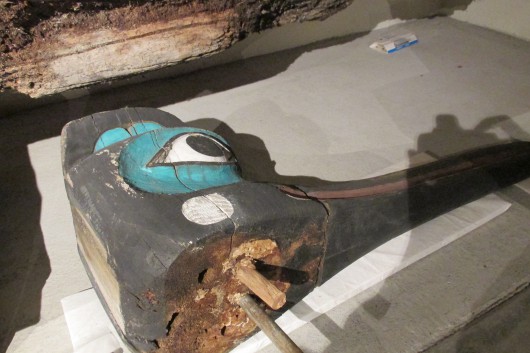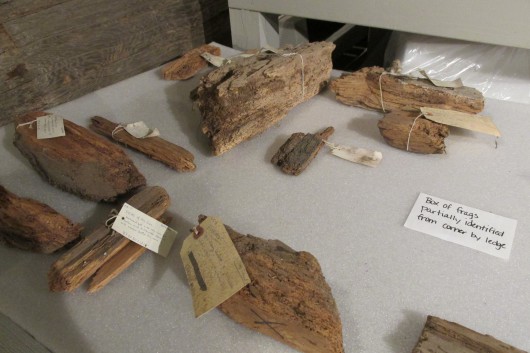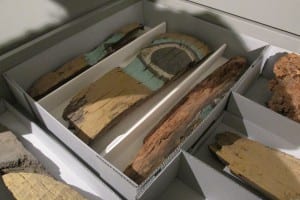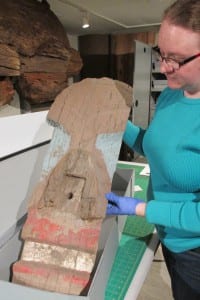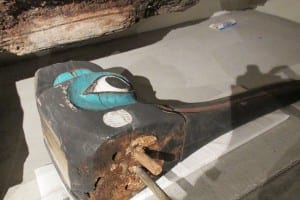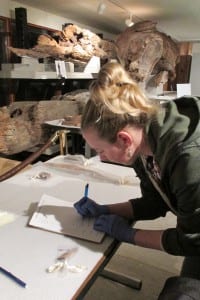Ketchikan Museums staff has been working to catalog, document and store totem pole fragments that have been in the museum’s collection for 40 years. The fragments can provide details lost on many of the larger poles.
Hayley Chambers is the museum department’s senior curator of collections. She says the Haida poles stored at the Totem Heritage Center came from Old Kasaan and the Tlingit poles from Tongass and Village Islands. The poles were collected in the 1960s and 70s. Fragments also were collected at that time, and pieces that have broken off the center’s poles over the past 40 years have been retained. Chambers says the fragments have been cared for at the center, but never processed.
“It was an area of our collection’s care that was just in need. It was a great grant opportunity to help us address that.”
Chambers says the museum received a grant through Museums Alaska and was able to purchase cabinets and archival-quality boxes to store the fragments. She says anything fully detached from the parent pole is considered a fragment.
 “A fragment can range in size from being a large, decorative element like a wing or a beak or a face, like this one. It can also go down to just a small sliver of wood.”
“A fragment can range in size from being a large, decorative element like a wing or a beak or a face, like this one. It can also go down to just a small sliver of wood.”
Chambers says some pieces are unidentifiable, but many were labeled or have hints of color or carving marks that indicate they came from a larger piece. She says fragments are important because many show details no longer visible on most of the larger poles.
“It’s exciting to see what the pigment had looked like originally. I think things like that help to provide that visual for people, that these poles, when they were standing originally, were painted and decorated. A lot of that detail on older poles has been lost over time just as they’ve been outside and weathered and aged.”
Chambers says one of those poles is the Coast Guard Pole carved in the late 1800s. The pole came from Village Island, was moved to the Coast Guard Base on Annette Island and then transferred to the Totem Heritage Center in the late 1960s. Chambers says a found fragment was labeled, possibly at the time of collection, so staff was able to match it to the proper pole.
“The pole today has no paint that’s really visible. There are some faint remnants of red paint towards the face of it. When we were unpacking our totem pole fragments, we found a large piece and it still has paint on it and it’s fairly vibrant paint. It’s red, blue and white paint. It’s really exciting to see that.”
Chambers says other fragments illustrate a carver’s unique signature and style. She says smaller, detached pieces also provide information on how different poles were constructed and assembled.
“Wings and beaks especially have had different methods of having them attached. Some have used bolts. Some have wooden pockets where pieces slide in and connect that way. Also, repairs are kind of interesting because repairs have changed quite a bit over time.”
Chambers says the museum has a few poles and fragments that show repairs using metal rods, a practice not done today. She says it’s interesting to see how conservation methods have changed over time.
Museum staff members have been helping to catalog and process the fragments. Administrative Secretary Tara Hofmann says she knew Chambers needed help, but also is interested in any project where she can learn more about artifacts.
“It was also just very interesting to see what can happen to a totem pole and that we need to take care of them in every way, shape and form that we can. Otherwise we end up with pieces like this if we are not being as careful as we can in conserving those poles.”
A data sheet is filled out for each piece which is given a unique identification number. If possible, pieces are cleaned, but many are too fragile. Some are stored in clear archival bags while others are placed, unwrapped, in archival boxes. Hofmann says each piece is photographed and measured, and detailed descriptions and conditions noted. She says describing a piece can be difficult.
“I can talk about the color, I can talk about the strand trying to fall off here, the shape, where it points at one end and thickens on the other end. But, unless there’s any sort of real carving or decoration, it’s basically just describing a piece of wood the best that you can.”
Chambers and Hofmann say they have processed most of the more than 100 fragments, and plan to complete the project soon. Chambers says she is writing up cataloging and storage procedures so that the process can continue in the future.
The Totem Heritage Center is celebrating its 40th anniversary, and most of the fragments have been in storage that long. Chambers says it was a goal to give fragments the care they need and proper storage during this anniversary year.

